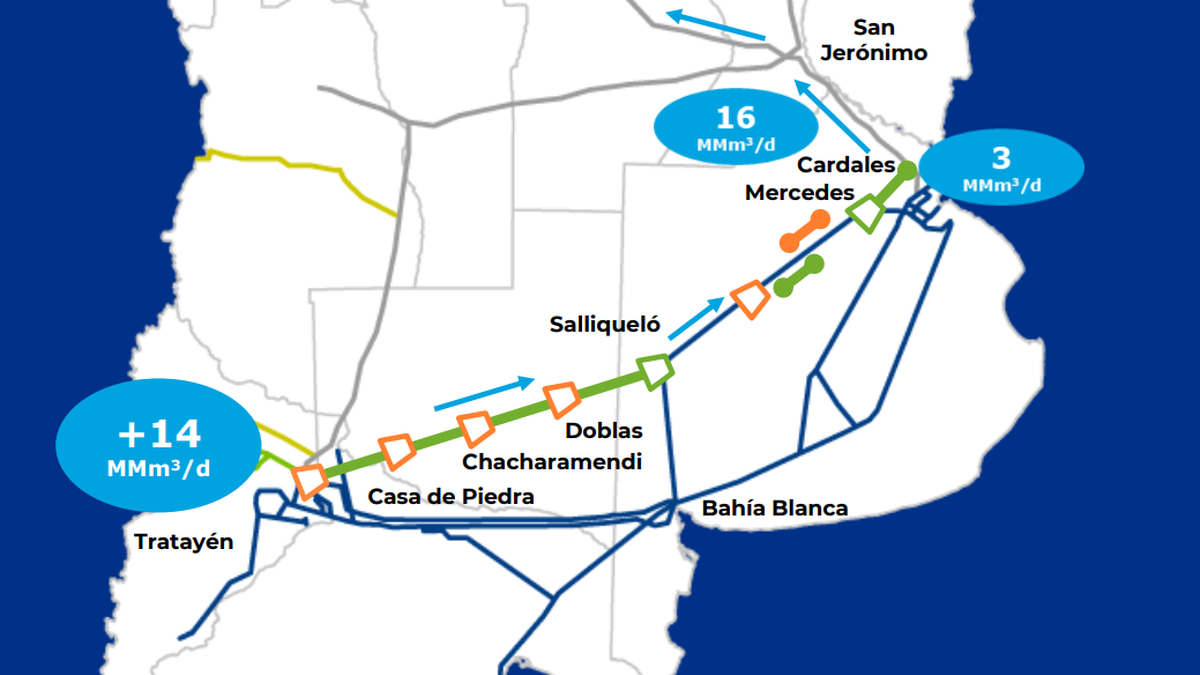By highlighting that the energy works have to be carried out by the private sector, the official assured that “The best example is a private initiative presented by TGS, which probably tomorrow (Wednesday, November 26) we will be declaring of public interest”he advanced.
As he said Daniel Gonzalezif this initiative succeeds, the Perito Moreno Gasduct (former Néstor Kirchner) The National State is not going to expand it and the off-taker, that transport, is not going to be the National State either. “The gas pipeline is supported by a private sector with contracts with other private companies. This paradigm shift is better, it shows that eight months after the start of the Government, Argentina’s private sector is prepared for this change,” he stressed.
It is about the Private Initiative to Expand the Argentine Gas Transportation System (IPASTGA)that the company controlled by Pampa Energy and the family Sielecki has already presented to the Ministry of Economy of Luis Caputoand as this media learned, it was well received.
According to the details of the project you accessed Energy Reportthe main purpose of the private initiative is to make available significant incremental volumes of natural gas in the Coastal area, with 14 million cubic meters per day (MMm3/d) additional from June 2026.
What is the Private Initiative to Expand the Argentine Gas Transportation System (IPASTGA) like?
The project for the execution and financing of works to expand existing transportation systems will have a total associated investment of US$700 millionof which some US$500 million could enter the RIGI if the Chamber of Deputies finally sanctions the Bases law.
“The project is based on the maximum use of the existing transportation infrastructure, highly efficient in terms of the amount invested per cubic meter transported, which translates into a lower cost for the end user, in addition to shorter construction times,” they emphasized from TGS.
The drivers of IPASTGA They assure that with these works they seek to give “reliability” to the energy supply and replace LNG and diesel imports with Vaca Muerta gas for at least 100 days a yearwhile allowing export balances to the region, via Uruguay or Brazil.
The calculations of TGS indicate that by taking advantage of gas Dead Cow To cover the gas deficit, payment for current LNG and diesel imports would be avoided, with prices between US$11 and US$18 per million BTUwhich are between three and five times higher at the prices that are marketed from the Neuquén Basin.
Although TGS clarified that the project is complementary and in “no way excludes” the possibility of moving forward with the construction of Section II of the Néstor Kirchner Gasduct, the layout of the IPASTGA reflects a virtual replacement of that work already underway, which is quoted at around US$2.5 billion in total and would take more time to complete. “This initiative is much cheaper, more efficient and with lower costs and times, because it allows gas to be available in the winter of 2026”detailed a source linked to the project.
image.png
Néstor Kirchner Gasduct. The works on section II with the compressor plants and the Reversal of the Northern Gas Pipeline are already underway.
What’s more, almost at the same time TGS aired his initiative, Enarsa reported that on June 15, tests began at theTrayén Compressor Plant, as rescheduled.or, for the Early Functioning Appropriate (APF).
Embed – https://publish.twitter.com/oembed?url=https://x.com/Energia_ArgOk/status/1803421639775793604&partner=&hide_thread=false
The expansion works plan is designed in two systems with differentiated regulatory frameworks, and according to TGSwould be complementary to any other infrastructure work that allows promoting the development of Dead Cow and regional energy integration.
However, Sector sources have already expressed concern about the possible fall in ostracism of Tranche II of the GPNK if this initiative moves forward. One of the doubts is how it would be connected with the Reversion of the Northern Gas Pipeline to reach the provinces of the NOA with gas from Vaca Muerta.
Capacity Expansion Works on Section I of the GPNK (Law 17,319)
On the one hand, it is proposed to execute a work on theTrayén–Salliqueló Section of the Néstor Kirchner Gasductunder the Hydrocarbon Law and applying the RIGIwhich requires a competition process to receive and award the offers presented by those interested in its execution.
This first part of the work at the GPNK includes the installation of three new compressor plants with a total of 90,000 HP and an investment of around US$500 million.
image.png

Complementary Expansion Works in the Final Sections of the TGS Regulated System (Law 24,076)
On the other hand, the project is complemented with an expansion in the regulated system of TGSwhich it will finance and execute under the terms of its license, and which will allow the incremental natural gas that reaches Salliqueló through the GPNK to access the Greater Buenos Aires area, to then be transferred to the TGN towards the coastal area.
The work in the regulated system of TGS It includes the installation of 20 km of pipe loops and the installation of 15,000 HP of compression in the Neuba II Gas Pipelineplus other works and tests to raise its maximum operating pressure, with an estimated investment in US$200 million that TGS would financealthough it is not awarded in the expansion of the GPNK.
image.png

What are the benefits of the TGS initiative to expand gas transportation
- This project is superior to any other alternative for the efficient investment amount, by taking advantage of the use of existing infrastructure.
- The benefits in the trade balance from Argentina will amount to more than US$700 million per year and, in terms of fiscal savings, in the order of US$500 annually, due to the substitution of these imports once the project is enabled.
- As demand for gas in the domestic market decreases, balances may be exported to countries in the region in the summer period.
- The project will reactivate the growth of various economic sectors. For example, in the upstream, to achieve the development of 14 MMm3/d of incremental natural gas production approximately 20 wells will need to be drilled and completed in the initial stage in Vaca Muerta, with an estimated investment of US$400 million.
- But also, the investments required in the midstream that would add another US$450 million in conditioning facilities for the new gas to be transported.
Necessary stages for the authorization of the IPASTGA project
- Analysis and approval of the proposal by the National Executive Branch.
- Preparation of Tender Documents by the National Executive Branch.
- Analysis of Offers received.
- Award, which includes the granting of the partial transfer of the Transportation Concession before November 1, 2024, to be able to have winter 2026 work authorization.
What the directors of TGS, Pampa Energía and Grupo Sielecki said
image.png

Luis Fallo (Sielecki Group), Oscar Sardi (TGS) and Gustavo Mariani (Pampa Energía).
Oscar Sardi, CEO of TGSrecalled that the reserves of Dead Cow They are “equivalent to more than 120 years of domestic consumption” and added that “it is imperative that Argentina has the necessary infrastructure that allows it to capitalize on these resources during the energy transition.”
“We are convinced that it is the most efficient expansion work alternative at this time. Its great contribution to supply and its shorter construction period will allow Argentina, starting in 2026, to prioritize its own resources, stopping spending US$700 million per year on imports that could be replaced by gas from Neuquén at a cost of US$200 million.generating significant savings and guaranteeing internal supply every winter,” Sardi stressed.
Gustavo MarianiCEO of Pampa Energyassured that “if the Bases law is approved, the framing of private investment within the RIGI “It will result in lower gas transportation rates for users.”
Luis Falloexecutive director of Sielecki Grouphighlighted that since 2019 the company TGS “has been investing more than US$700 million in midstream facilities to accompany the development promoted by gas producers in Vaca Muerta” and that this project, which adds another US$700 million, “reinforces the vocation of TGS and its shareholders to trust and bet on the economic and social growth of the country.”
Source: Ambito
I am a 24-year-old writer and journalist who has been working in the news industry for the past two years. I write primarily about market news, so if you’re looking for insights into what’s going on in the stock market or economic indicators, you’ve come to the right place. I also dabble in writing articles on lifestyle trends and pop culture news.




